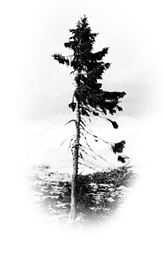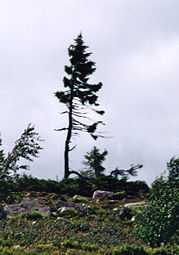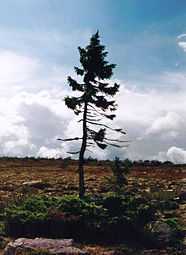Old Tjikko

Old Tjikko is a 9,550-year-old Norway Spruce tree, located on Fulufjället Mountain of Dalarna province in Sweden. Old Tjikko is the world's oldest known living individual clonal tree. However, there are many examples of much older clonal colonies (multiple trees connected by a common root system), such as "Pando", estimated to be over 80,000 years old.
The age of the tree was determined by carbon dating of the root system under the tree, not by dendrochronology, or counting tree rings. The trunk itself is estimated to be only a few hundred years old, but the tree as a whole may have survived for much longer due to a process known as layering (when a branch comes in contact with the ground, it sprouts a new root), or vegetative cloning (when the trunk dies but the root system is still alive, it may sprout a new trunk).
The oldest living non-clonal tree, verified by dendrochronology, is 5064 years old as of 2014 (the former record was held by "Methuselah" (4847)). Both trees are Great Basin Bristlecone Pine located in California. Vegetative cloning and reproduction is common in many plants, such as the creosote bush (see "King Clone", estimated from growth rate to be almost 12,000 years old). Many other plants also may take advantage of this process either exclusively or in tandem with sexual reproduction, but dating or estimating the age of these organisms may not be possible without evidence (e.g., old roots, ancient remains, consistent growth rates).
Discovery and details

Old Tjikko is estimated to be at least 9,550 years old, making it the world's oldest known individual vegetatively cloned tree. It stands 5 metres (16 ft) tall and is located on Fulufjället Mountain of Dalarna province in Sweden.[1] For thousands of years, the tree appeared in a stunted shrub formation (also known as a krummholz formation) due to the harsh extremes of the environment in which it lives. During the warming of the last century, the tree has sprouted into a normal tree formation. The man who discovered the tree, Leif Kullman (Professor of Physical Geography at Umeå University), has attributed this growth spurt to global warming, and given the tree its nickname "Old Tjikko" after his late dog.[1]
The tree has survived for so long due to the cloning process from which many trees can benefit. The visible tree is relatively young, but it is part of an older root system which dates back thousands of years. The trunk of the tree may die and regrow multiple times, but the tree's root system remains intact and in turn sprouts another trunk. The trunk may only live for about 600 years, and when one trunk dies another eventually grows back in its place.[2] Also, each winter, heavy snow may push the tree's low-lying branches to ground level, where they take root and survive to grow again the next year[3] in a process known as layering. Layering occurs when a tree's branch comes in contact with the earth, and new roots sprout from the contact point. Other trees, such as coast redwoods and western redcedars are known to reproduce by layering.[4] The tree's age was determined by carbon-14 dating of the root system, which found roots dating back to 375, 5,660, 9,000, and 9,550 years. Carbon dating is not accurate enough to pin down the exact year the tree sprouted from seed, but given the estimated age the tree is supposed to have sprouted around 7550 BC. For comparison, the invention of writing (and thus, the beginning of recorded history) did not occur until around 4000 BC. Researchers have found a cluster of around 20 spruce trees in the same area, all over 8,000 years old.[5][6]
Previous researchers considered the Norway spruce species to be a relative newcomer to Sweden, with theories postulating the tree migrated into the area around 2,000 years ago. Trees much older than 10,000 years would be practically impossible in Sweden, because until around 11,000 years ago the area was in the grip of a world-wide ice age.[2] Nature conservancy authorities are considering putting a fence around the tree to protect it from possible vandals or trophy hunters.[7]
Images
See also
| Wikimedia Commons has media related to Old Tjikko. |
- List of oldest trees
- List of famous trees
References
- ↑ 1.0 1.1 Landau, Elizabeth. "World’s oldest tree points to global warming impact". CNN. Retrieved 6 May 2008.
- ↑ 2.0 2.1 Owen, James. "Oldest Living Tree Found in Sweden". National Geographic. Retrieved 6 May 2008.
- ↑ "Swedes find 'world's oldest tree'". BBC News. 17 April 2008. Retrieved 6 May 2008.
- ↑ "World’s Oldest Tree Discovered?". Western Institute for Study of the Environment. 20 April 2008. Retrieved 12 April 2009.
- ↑ "World’s oldest living tree discovered in Sweden". Umeå University. Retrieved 6 May 2008.
- ↑ Kirkebøen, Stein Erik (24 April 2010). "Verdens eldste tre". Aftenposten (in Norwegian). p. 14. Retrieved 30 April 2010.
- ↑ Highfield, Roger (17 April 2008). "World's oldest tree discovered in Sweden". London: Telegraph Media Group. Retrieved 6 May 2008.




